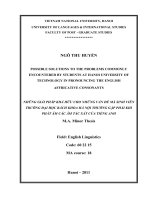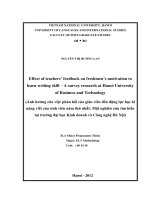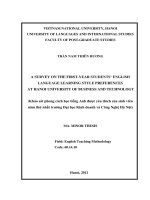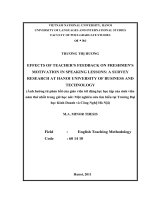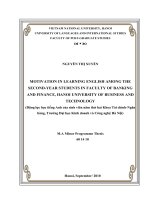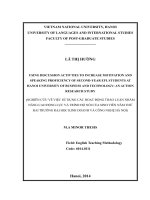Effect of teachers' feedback on freshmen's motivation to learn writing skill - a survey research at Hanoi University of business and technology
Bạn đang xem bản rút gọn của tài liệu. Xem và tải ngay bản đầy đủ của tài liệu tại đây (647.41 KB, 89 trang )
VIETNAM NATIONAL UNIVERSITY, HANOI
UNIVERSITY OF LANGUAGES AND INTERNATIONAL STUDIES
FACULTY OF POST-GRADUATE STUDIES
NGUYỄN THỊ HƯƠNG LAN
Effect of teachers’ feedback on freshmen’s motivation to
learn writing skill – A survey research at Hanoi University
of Business and Technology
(Ảnh hưởng của việc phản hồi của giáo viên đến động lực học kĩ
năng viết của sinh viên năm thứ nhất: Một nghiên cứu tìm hiểu
tại trường đại học Kinh doanh và Công nghệ Hà Nội)
M.A Minor Programme Thesis
Major: ELT Methodology
Code : 60 14 10
Hanoi - 2012
VIETNAM NATIONAL UNIVERSITY, HANOI
UNIVERSITY OF LANGUAGES AND INTERNATIONAL STUDIES
FACULTY OF POST-GRADUATE STUDIES
NGUYỄN THỊ HƯƠNG LAN
Effect of teachers’ feedback on freshmen’s motivation to
learn writing skill – A survey research at Hanoi University
of Business and Technology
(Ảnh hưởng của việc phản hồi của giáo viên đến động lực học kĩ
năng viết của sinh viên năm thứ nhất: Một nghiên cứu tìm hiểu
tại trường đại học Kinh doanh và Công nghệ Hà Nội)
M.A Minor Program Thesis
Major : ELT Methodology
Major code: 60 14 10
Supervisor : Đỗ Thị Thanh Hà, M.A
Hanoi - 2012
iv
Table of content
PART A: INTRODUCTION………………………………………………………1
1. Rationale…………………………………………………………………… 1
2. Aim of the study………………………………………………………… ………2
3. Scope of the study………………………………………………………………2
4. Research questions …………………………………….………………………3
PART B: DEVELOPMENT ………………………………………… ………… 4
Chapter I. Literature review………………………………………….……4
I.1. Motivation…………………………………………………… ………………4
I.1.1. Definition of motivation………….……………………………….….………4
I.1.2. Motivation in second/foreign language learning ………….…… ……5
I.1.3. Types of motivation and their effect in language learning….……………6
I.1.4. Vietnamese students’ motivation in learning writing ……….……………7
I.1.5. Summary of main issues in motivation and Vietnamese students’
motivation in learning writing……… ………………………………………8
I.2. Teacher feedback ……………………………………………….……………9
I.2.1. Definition of teacher feedback in language learning and teaching……9
I.2.2. Feedback as an extrinsic motivation to student learning ……………10
I.2.3. Feedback in teaching and learning writing ……… ………………… ……13
I.2.4. Types of feedback in teaching writing ………………………………14
I.2.5.What types and what ways of teacher feedback best motivate students to
write? …………………………………… ………………………….……18
I.2.6. Summary of teacher feedback and it effect on student motivation to w r i t e
………………………………………………………………………………21
Chapter II. Methodology ………………………………………………….………….22
v
II.1. Context of the study…………………………………… ………….………22
II.1.1. Time distributed to English at HUBT……………………………… 22
II.1.2. English course book at HUBT………………………………………22
II.1.3. Time and schedule distributed for writing skill………… …………23
II.1.4. How HUBT teachers give feedback to student writing …….………24
II.2. Participants……………………………………….…….……………………25
II.3. Data collection instruments………………….……………… ………….…25
II.4 Data collection procedure and analysis ……………………………………27
Chapter III. Finding ……………………………………………………….……29
III. 1. Written feedback. …………………………………………………………29
III.1.1. Types of written feedback HUBT teachers use in writing
lesson………………………………………………………………………29
III.I.2.The influence of teacher written feedback on HUBT freshmen’
motivation to write …………………………………………………… …31
III.1.3. The methods HUBT teachers give written feedback in writing
lessons……………………………………………………………… ……33
III.1.4. The influence of written- feedbacks-giving methods on HUBT
freshmen’s motivation to write ………………….………………………36
III.2. Oral feedback………………………………………………………………40
III.2.1. Types of oral feedback HUBT teachers use in writing
lesson………………………………………… ……………………………40
III.2.2. The influence of teacher oral feedback on HUBT freshmen’
motivation to write ………………………………………………………41
III.2.3.Whether oral or written feedback encourages HUBT freshmen to
write more.………………………………………………………… ……43
Chapter IV. Discussion ………………………………………….………………46
vi
IV.1.Written feedback……………………………………………………………46
IV.1.1.The types of teacher written feedback in writing lessons and their
influence on HUBT freshmen’s motivation to write ……… ………….…46
IV.1.2.The methods teachers give written feedback in writing lessons and
their influence on HUBT freshmen’s motivation to write …… ……… 48
IV.2. Oral feedback……………………………………….……… ……50
IV.2.1.The types of teacher oral feedback in writing lessons and their
influence on HUBT freshmen’s motivation to write …………… ……50
IV.2.2.Oral feedback versus written feedback …………………… ………51
IV.3. General discussion on HUBT teacher feedback on freshmen’s motivation
to write ……………………………………………………………………… ….52
PART C. Conclusion…………………………………………………….…… 54
1.Summary of the finding…………………………………….………………54
2.Recommendation ……………………………………………………………55
3.Limitations…………………………….………………………….…………56
4.Suggestion for further studies………………………………………………57
References ……………………………………………………………… …… 58
Appendix 1. Questionaire –English version…………….….………………………I
Appendix 2. Questionaire –Vietnamese version….………….…………………VI
Appendix 3. Interview transcript with students ……….…………………… …XII
vii
List of abbreviations
HUBT
Hanoi University of Business and Technology
EFL
English as a Foreign Language
List of tables and charts
List of tables
1. Table 1.Williams and Burden's (1997) framework of motivation in language
learning, (cited in Dornyei, 1998)………………………………………….… 10
2. Table 2 .Components of foreign language learning motivation (Dornyei,
1994a: 280, cited in Dornyei, 1998) ………………………………….……… 11
3. Table 3.The category of feedback in teaching writing employed in this study
……………………………………………………………………………………… 17
4. Table 4.Description of the questionnaire … ………………………………….26
5. Table 5: The frequency of HUBT teacher written feedback in writing
lessons…………………………………………………………………………… 29
6. Table 6: The influence teacher written feedback on HUBT freshmen’s
motivation to write ………………………………………… ….……………… 31
7. Table 7: The frequency of the methods HUBT teachers give written feedback
in writing lessons ……………………………………………… …….………….33
8. Table 8: The influence of feedback-giving-methods on HUBT freshmen’s
motivation to write ……………………………………………… …………….37
9. Table 9: The frequency of HUBT teacher oral feedback in writing lessons
……………………………………………………………………………………….40
10. Table 10: The influence of HUBT teacher oral feedback on freshmen
motivation to write ……………………………………………………………… 41
11. Table 11: Oral feedback versus written feedback ………… ……………… 43
12. Table 12: The reasons for oral feedback ………………………………….44
13. Table 13: The reasons for written feedback ……………………………………45
viii
List of charts
1. Chart 1: The frequency of HUBT teacher written feedback in writing lessons
……………………………………………………………………………………… 30
2. Chart 2: The influence teacher written feedback on HUBT freshmen’s
motivation to write ……………………………….……………………………… 32
3. Chart 3: The frequency of the methods HUBT teachers give written feedback
in writing lessons ………………………………………………… …………… 35
4. Chart 4: The influence of feedback-giving-methods on HUBT freshmen’s
motivation to write………………………………………………………….……. 38
5. Chart 5: The frequency of HUBT teacher oral feedback in writing
lessons……………………………………………………………………………… 40
6. Chart 6: The influence of HUBT teacher oral feedback on freshmen
motivation to write …………… ………………………………………………….42
7. Chart 7: Oral feedback versus written feedback ………………………………43
1
PART A: INTRODUCTION
1. Rationale
There are four main reasons for this study. Firstly, as a teacher of English at
Hanoi University of Business and Technology (hereafter HUBT), the author notices
that HUBT freshmen need motivation in learning writing. Many of HUBT freshmen
show their frustration when writing. They complain about the difficulties and low
scores in writing. Besides, their writing still has many mistakes. Therefore, it is
necessary for teachers to find out the way to motivate them to learn writing skill.
Also, it is worth finding out the impact of teacher response on their motivation,
because giving feedback in writing class is generally considered as an important
stage in teaching writing.
The second reason for this study is the need for an investigation of the effect
of teacher feedback on students’ written works at HUBT. If their teachers do not
give as much comment as students expect, they show a disappointment. Otherwise,
if students receive a paper back with a lot of teacher- red-pen comment and
correction, they feel frustrated, too. Some students do not understand the meaning
of their instructors’ feedback. Furthermore, HUBT teacher’s practice of giving
feedback in writing session is different. How do the different types of feedback
motivate students? Therefore, this study is to find out the answer to this problem.
Thirdly, there have been disagreements on which kind of teacher feedback
best stimulate students to write. The examples include the argument between
Truscott (1996, 2007) and Ferris (1999, 2001) (cited in Park, 2006), the different
results in the researches by Vengadasamy (2002), Duppenthaler (2002) Ashwell
(2000) , Conrad & Goldstein (1999) and so on. This study, therefore, is expected to
contribute an answer to this debate.
Lastly, this research is inspired by several previous studies relating to the
topic and within the context of HUBT. The examples are the studies on the
motivation to learn English in general of HUBT students who are major in Finance
2
and Banking (Nguyen, 2010), and on the effect of teacher feedback on their
motivation in speaking (Truong, 2011). However, the participants of those studies
are limited only to the majors in Finance and Banking. Therefore, the author of this
paper wants to widen the participants who are from several departments but share
the same course book and English schedule, as well as to widen the area of
research: teacher feedback in teaching writing and its effect on learner’s motivation.
All the reasons above inspire the author to do this research to find out the
influence of teacher feedback (both written and oral) on first- year- student’s
motivation to write.
2. Aim of the study
This study intends to seek the influence of teacher feedback on freshmen’s
motivation to write.
3. Scope of the study
Because this study only investigates the impact of teacher feedback on
student’s motivation to write, it does not look into the impact of non-teacher
feedback such as peer-respond and self-correction. In addition, it does not study the
correction ability, revision ability, the performance or improvement of students
under the effect of teacher feedback.
There have been a great number of studies on the influence of written
assessment to learners’ writing, such as Hyland & Hyland (2001), Duijnhouwer
(2010), Ashwell (2000), Duppenthaler (2002), and Ferris (1997). However just a
few researchers mention the oral feedback in writing class, such as teacher-student
conference, teacher-class discussion. Meanwhile, in writing session at HUBT, many
teachers choose and take advantages of oral feedback. Because teacher feedback
can be in written or oral form, this study will discuss the effect of both kinds of
feedback, instead of limiting to only written one.
It is also important to note that the participants of this study are the non-
English major freshmen at departments of Banking, Management, Finance,
Accounting at HUBT. According to Nguyen (2010), they share the similar
3
motivation to learn English. The author does not include the freshmen at other
departments such as Architecture, Tourism, Electronics, because their motivation
differs from the one of freshmen at the departments mentioned above.
4. Research questions
1. What kinds and what ways of teacher - written - feedback are used in writing
session for freshmen at HUBT?
2. How do those written feedbacks influence HUBT freshmen’ motivation to write?
3. What types of teacher - oral - feedback are used in writing session for freshmen at
HUBT?
4. How do those oral feedbacks can motivate HUBT freshmen to write?
5. Whether HUBT freshmen prefer written or oral feedback?
4
PART B: DEVELOPMENT
Chapter I. Literature review
I.1. Motivation
I.1.1. Definition of motivation
Firstly, let’s discuss what motivation is. Motivation is mainly seen under the
view of psychology. Yuan Kong, in 2009, issued a good comprehensive study on
motivation in English Language learning. Motivation, in the psychological
understanding, as he summarizes from the view of Paul Eggen & Don Kauchak,
(1994) is seen as ―a force that energizes and directs behavior toward a goal‖.
Motivation moves a person just like a force moves an object. He also summarizes
the three function of motivation: (i) energizing us, (ii) directing us, (iii) help us to
select the most appropriate behaviors to achieve our goal. In accordance with this
sight, Dornyei (1998) defines ―motivation is responsible for determining human
behavior by energizing it and giving it direction‖. Motivation is also seen under the
view of mental process, such as the opinion of Pintrich and Schunk (1996, cited in
Dornyei, 1998): ―'Motivation is the process whereby goal-directed activity is
instigated and sustained‖. In other words, motivation involves various mental
processes that lead to the initiation and maintenance of an action.
We could have many definitions of motivation, they can be different in
words, but they agree on its functions or responsibilities of driving people to
achieve something they want. These definitions are easy to understand and help us
to be aware of the importance of motivation in any activity and process of humans
in life. Motivation is invisible, however, it underlines this or that action a person
does to achieve this or that result. Without motivation, any activities of people can
be come boring. Because of this, many researchers have found the way to increase
the level of motivation, so that people can be encouraged achieve this or that goal.
And, motivation in language learning is an outstanding field of motivation
5
researching. Now, we are going to look into the role of motivation in language
learning.
I.1.2. Motivation in second/foreign language learning
Motivation plays a very crucial role in language learning. Because of its
important role and effect, motivation has been highlighted and investigated a lot to
find out the implication for educators in language learning in general and
second/foreign language in particular. For example, according to Dornyei
(1998:117), motivation has been widely accepted by both teachers and researchers
as one of the key factors that influence the rate and success of second/foreign
language learning. He explains that motivation provides the primary impetus to
initiate learning the language and later the driving force to sustain the long and
often boring learning process. Without sufficient motivation, even individuals with
the most remarkable abilities cannot accomplish long-term goals, and neither are
appropriate curricula and good teaching enough on their own to ensure student
achievement. On the other hand, high motivation can make up for considerable
deficiencies both in one's language aptitude and learning conditions.
Another researcher, Kong (2009:146) contends that, motivation is not only
an intensive desire for learning and acquiring knowledge of English (as a foreign or
second language), but also an inner cause that pushes students forward in English
learning with enthusiasm and willingness. It is something like the engine and
steering wheel of an automobile that can moves students from boredom to interest.
It is an inner power to drive and persevere students in English learning. Students
who have strong learning motivation take a correct and positive attitude towards
study and make great efforts to master English with clear goal and desire and
consequently gain better grade than those who have not acquired motivation and
those students usually regard English learning as a heavy and boring burden. It is
true that motivation is such a basic factor in language learning that no teacher could
avoid being concerned with students’ motivation.
6
To sum up, the role of motivation in second/foreign language learning is
considered as the initial, the key factor to the success. However, students differ in
the level and orientation of motivation. (Ryan & Deci, 2000:54). For instance, a
student can be highly motivated to do homework out of curiosity and interest or,
alternatively, because he or she wants to obtain the approval of a teacher or parent.
Consequently, the implication for educators and teachers is to find the suitable ways
to motivate students to learn.
I.1.3. Types of motivation and their effect in language learning
Many researchers divide motivation in two main types: intrinsic and
extrinsic. Intrinsic motivation refers to doing something because it is inherently
interesting or enjoyable; and extrinsic motivation refers to doing something because
it leads to a separable outcome (Ryan & Deci, 2000:55). Both intrinsic and extrinsic
motivations are important, inseparable and complementary to each other in English
learning. (Kong, 2009:146). It is believed that intrinsic motivation has long term
effect to push student to study by its own curiosity and interest. However, in the
real world not all of the students are automatically energized to perform this or that
task, or to learn about this or that topic. Instead, they are driven by extrinsic
impetus. Sometimes, a good grade, a reward, the threat of failing and praise move
students from an inactive to an active state. Hence, extrinsic motivation becomes
an essential strategy for successful teaching and learning.
Another kind of motivation is instrumental motivation. Gardner (2001:10,
cited in Cote & Waugh, 2004) wrote that such motivation could be considered by
some to be learning a target language simply to get ahead in society or to gain
social recognition or economic advantages through knowledge of a foreign
language. Cote & Waugh (2004) give some examples of instrumental motivation:
the people who learn a foreign language to get a job, to make money to survive, or
just to communicate with foreigners, to read a novel and so on.
7
Instrumental motivation has also been found to play an important role in the
classroom. To support this view, Gardner and MacIntyre (1995, cited in Cote &
Waugh, 2004) maintain instrumentally motivated students of foreign language study
longer than non-instrumentally motivated students when there are an opportunity to
profit from learning.
To summarize, we have three main types of motivation: intrinsic, extrinsic,
and instrumental. Certainly, it is best when learners of foreign/second language are
driven by intrinsic impetus (e.g. they learn a language because they like it).
However, the number of such students is limited. At school, students are concerned
with many other subjects in addition to a second/foreign language; therefore, their
enthusiasm for this subject could be affected negatively. In this case the
responsibility of teachers is to find some methods as extrinsic/ instrumental motion
to push their students to learn.
I.1.4. Vietnamese students’ motivation in learning writing
Tran (2007) presents a valuable study on Vietnamese students’ motivation in
writing by reviewing the study by Ellis (1996) and Le (2000) and herself (2001). In
Ellis’ view, Vietnamese EFL (English as a Foreign Language) learners’ motivations
are shaped by the ―teacher’s initiative‖ and the ―students’ will to succeed‖ (mainly
in examinations). Next, she shares the view that Vietnamese learners are bound to
extrinsic motivation as a result of ―the pressure to pass exams.‖ Moreover, many
Vietnamese students tend to be more interested in learning other skills such as
speaking, reading and listening than writing and writing seems to be regarded as a
chore or a burden, for a homework exercise always waiting for them after each
writing lesson. In addition, most students consider writing difficult and
unrewarding. It is obvious that lack of interest and motivation in writing is a
problem facing many students in Vietnam. How to help students overcome this has
long been a major concern and a challenge to Vietnamese teachers of writing (Tran,
2001).
8
The result of Tran’s study (2007) indicates that Vietnamese students
nowadays have not only extrinsic motivation to write, but also intrinsic motivation.
Moreover, the study brings a new image of Vietnamese students who show their
potential to write independently, creatively and passionately if they are really
motivated. This reflects an image of students who are able and ready to write with a
sense of authorship in a foreign language, which is different from how they appear
to be in the routine. Tran also points out that teacher’s enthusiasm in giving
feedback to students’ writing is one of the sources of motivation which stimulate
them to write. However, the participants of her study are limited to the English-
majors, which leaves a gap in the investigation of non-English majors’ writing
motivation.
I.1.5. Summary of the main issues in learner’s writing motivation
Motivation plays a crucial role to the success of a person in life in general
and in learning process in particular. There are three main types of motivation:
intrinsic, extrinsic and instrumental one. These types closely relate, affect, support
or weaken each other. Therefore, it is an implication for any teacher to find the way
to motivate learners.
In case of Vietnamese students’ enthusiasm to learn writing skill, it is
traditionally believed that writing is less favorable than other skills, there is a low
interest and motivation in writing. On the other hand, recently, this belief has been
change by such study by Tran (2007), in which Vietnamese student are found to be
more independent and creative. Therefore, we need more research which investigate
the Vietnamese learner’s motivation in writing, especially with the non-English
majors.
Although there are a lot of elements that influence learner’s motivation, in
writing skill, teacher feedback is very important. This is also the focus of this study,
hence, we come to the next issue: teacher feedback and it effect on learner
motivation to write.
9
I.2. Teacher feedback and its effect on learner motivation to write
I.2.1. Definition of teacher feedback in language learning and teaching
In language learning and teaching, teacher feedback (or feedback in this
study) is defined in various ways. Written in Ferris (1999, cited in Park, 2006),
feedback is simply viewed as ―any response a teacher may give his or her students.‖
Ramaprasad (1983: 4, cited in Duijnhouwer, 2010) says: ―Feedback is information
about the gap between the actual level and the reference level of a system parameter
which is used to alter the gap in some way‖. Accordingly, Ur (1996:242), feedback
is ―information that is given to the learners about his or her performance of a
learning task, usually with the objective of improving this performance.‖
Duijnhouwer, (2010), after considering a number of feedback definitions, defines
feedback as ―information provided by an external agent regarding some aspect(s) of
the learner’s task performance, intended to modify the learner’s cognition,
motivation and/or behavior for the purpose of improving performance‖.
Although there are a lot of definitions, they mainly concern three main
elements: the information content, the aim, and the provider of feedback. Among
them, the aim or intention of feedback, is emphasized. It is to modify students’
thinking or behavior for the purpose of improving learning. In reality, many
teachers pay more attention to the content but forget the aim of their feedback. This
leads to a problem that teachers provide too much information on learner’s mistakes
and drawbacks, and do not care whether their feedback is to help or to make
learners lose confidence. Therefore, feedback, if given in the right manners,
contributes to motivate students, or it learner’s motivation has a relation, as the
definition of Duijnhouwer states. Hence, feedback plays an important role in
stimulating student in learning.
10
I.2.2. Feedback as an extrinsic motivation to student learning
There are many scholars confirm that teacher feedback is one of the element
of extrinsic motivation. William and Burden (1997, cited in Dornyei, 1998)
proposed a framework of motivation in language learning, with internal and
external factors. The external factors include the role of teacher as well as the nature
and amount of feedback.
Table 1. Williams and Burden's (1997) framework of motivation in language
learning, (cited in Dornyei, 1998)
Internal factors
Intrinsic interest of activity
• arousal of curiosity
• optimal degree of challenge
Perceived value of activity
• personal relevance
• anticipated value of outcomes
• intrinsic value attributed to the
activity
Sense of agency
• locus of causality
• locus of control RE process and
outcomes
• ability to set appropriate goals
Mastery
• feelings of competence
• awareness of developing skills and
mastery in a chosen area
• self-efficacy
Self-concept
• realistic awareness of personal
External factors
Significant others
• parents
• teachers
• peers
The nature of interaction with
significant others
• mediated learning experiences
• the nature and amount of feedback
• rewards
• the nature and amount of appropriate
praise
• punishments, sanctions
The learning environment
• comfort
• resources
• time of day, week, year
• size of class and school
• class and school ethos
The broader context
11
• strengths and weaknesses in skills
required
• personal definitions and judgements
of success and failure
• self-worth concern learned
helplessness
Attitudes language learning in general
• to the target language
• to the target language community
and culture
Other affective states
• confidence
• anxiey, fear
Developmental age and stage
Gender
• wider family networks
• the local education system
• conflicting interests
• cultural norms
• societal expectations and attitudes
Dornyei (1994a, cited in Dornyei 1998) also presents a table of components of
foreign language learning motivation. Teacher-specific motivational element with
feedback is also emphasized in the category.
Table 2 .Components of foreign language learning motivation (Dornyei, 1994a:
280, cited in Dornyei, 1998)
Language Level
Integrative Motivational Subsystem
Instrumental Motivational Subsystem
Learner Level
Need for Achievement
Self-Confidence
* Language Use Anxiety
* Perceived L2 Competence
* Causal Attributions
12
* Self-Efficacy
Learning Situation Level
Course-Specific Motivational
Components
Interest
Relevance
Expectancy
Satisfaction
Teacher-Specific Motivational
Components
Affiliative Motive
Authority Type
Direct Socialisation of Motivation
* Modelling
*Task Presentation
* Feedback
Group-Specific Motivational
Components
Goal-orientedness
Norm & Reward System
Group Cohesion
Classroom Goal Structure
It is easy to find out the role of teachers and their feedback in inspiring
students to learn in those frameworks. It is all considered as an extrinsic motivation.
In conclusion, in order to stimulate students, teachers should mind the effect of their
feedback.
To explain why teacher feedback could be a source of motivation to students
rather than other kinds of feedback such as peer feedback and self-assessment, let’s
see a view of Brookhart (2010, cited in Srichanyachon, 2012). For him, feedback
includes two factors: cognitive and motivational factors. It gives students
information they need so they can understand where they are in their learning and
what to do next—the cognitive factor. Once students feel they understand what to
do and why, most students develop a feeling that they have control over their own
learning—the motivational factor. Next, Srichanyachon (2012:8) believes ―Mostly
13
students from cultures that see a teacher as the only source of authority value
teacher revision more highly than other methods because they have confidence in
the teacher’s knowledge and skill in English.‖ All of the opinions above have
clearly explained why teacher feedback can stimulate students to learn.
I.2.3. Feedback in teaching and learning writing
Giving feedback seems to be a natural characteristic of teaching writing, and
its role is of importance to both teachers and learners. Magno and Amarles
(2011:21) says: ―Feedback plays a central role in developing writing proficiency
among second language learners‖. Park (2006) also confirms the importance of
feedback on student writing by saying that it has been considered as one of the
essential parts in a writing course. Students regard teachers' written feedback as
crucial to their improvement as writers. From teacher’s perspective, they seem to
think that it is a kind of duty as a writing instructor to help students, and it shows
teachers’ credibility.
Teacher feedback in writing, as well as teacher feedback in learning in
general, also is a source of motivation to learners. Srichanyachon (2012:13) reviews
the studies of other researchers such as Hyland and Hyland (2006); Richards and
Lockhart (1996) to conclude that teacher feedback can serve as a powerful tool to
motivate students in the writing process if done well. Another researcher, Saito
(1994) proves that students prefer teacher feedback to other kinds of feedback such
as peer feedback and self-correction. In case of Vietnamese students, as Tran (2007)
points out, teacher feedback is a source of motivation for them.
Since teacher feedback to student writing are expected to help students
develop their ideas fully and present them effectively, feedback needs to cover all
aspects of students’ written texts, including issues of content, organization, style,
grammar, and mechanics (Cohen & Cavalcanti, 1990; cited in Park, 2006). Next, it
should cover both strengths weaknesses of students (Magno & Amarles, 2011).
14
However, giving feedback is time and effort consuming, requiring teacher’s
enthusiasm (Conrad & Goldstein, 1999). Yet, because teachers think this is a duty,
many of them respond to students’ works like a ―mechanical activity‖, considering
this stage as a copy editing stage, focusing mostly on the correction of grammar
errors in student compositions. (Vengadasamy, 2002).This leads to the problems
that many teachers become ―error hunters‖ when they spend time looking into only
students’ surface errors. Another problem is teacher feedback becomes a threat, a
fear and makes students lose their confident. These dilemmas can be a demotivator
for students when they write
I.2.4. Types of feedback in teaching writing
Classification of feedback to students writing is different according to the
viewpoints and purposes of each researcher.
Park (2006) summaries the feedback in writing into three main types: form -
focused, content based and integrated feedback. Form-focused feedback, or
grammar correction, is one of the most commonly used methods from the past. This
feedback mainly focuses on student's grammatical knowledge and teachers give
corrections in only grammatical features. The second types of feedback is content-
based, in which teachers provide overall comments on where it doesn't make sense
in terms of content, or give some comments without pointing out specific
grammatical errors. Unlike form-focused feedback, content-based feedback focuses
more on content quality and organizational features in students' composition. The
last type is integrated feedback combining grammar correction with content-related
feedback. Besides, Park also mentions some other kinds of response to written
works such as direct and indirect feedback. With direct feedback, teachers give
direct correction. However, with indirect one, teacher gives indirect error pointer
using correction code which requires students themselves to correct errors. Park
calls the coded feedback ―techniques‖ because it helps students to find and identify
their mistakes.
15
Another type of feedback is electronic feedback using computers (Park,
2006). Teachers can provide comments on electronic submission by email and using
comment function. These new ways of feedback offer ―greater flexibility in their
responding practices‖, but we should consider the conveniences of both teacher and
students to have the highest effectiveness.
Magno & Amarles (2011), on the other hand, divide feedback into three
categories: feedback on form, on content and on writing style. Their definitions of
feedback on form and content are similar to the definitions of Park (2006). In term
of feedback on writing style, they defines it is the one ―involves assessment of the
use of language, persuasion, originality and creativity‖.
Saito (1994) gives six types of teacher feedback: teacher correction,
commentary, teacher correction with comments, error identification, teacher-student
conferencing, correction-using prompts. The teacher-student conferencing response
means teacher and student discuss a piece of student writing individually during the
writing of a composition, and after it is finished. In language learning, Saito review
the benefit of teacher-students conferences: two-way communication in a writing
conference appeared more effective than written comments because it allowed
students to explain their opinions and needs, and to clarify the teacher's comments.
Most of researchers concern written feedback rather than one-to-one conference,
There are some difficulties in running an individual conference between teacher
and learner, such as time constraint, as said by Vengadasamy (2002), large class-
sized, lack of teacher enthusiasm.
However, teacher-student conference is just one kind of teacher oral
feedback, which has not been investigated sufficiently. The most common type of
teacher spoken feedback is teacher-student (one to one) conference. Normally,
people think of a talk of ―twenty or thirty minute sessions in an instructor’s office‖
(Schiff, 2000:158); however, Schiff contends that it is not necessary like that. In
term of the place of the conference, it could be in a variety of unlikely settings-
hallways, cafeterias, libraries, and student lounges. Furthermore, when such
16
consultations focus on specific aspects of a particular piece of writing, they need
last only a few minutes. Therefore, teacher-student can be in form of a short
conversation, small discussion. Yet, not every student needs a conference. The
group/class conference is a productive alternative, allowing students to feel more
comfortable in a group setting and allowing you to easily discern who might need
more individual attention.
At HUBT, teachers usually choose class-discussion respond, in which they
summarize the most outstanding strengths/ drawbacks/error of students’ writing.
Otherwise, teachers can address some good or weak pieces of writing, so that the
class can gain some experience. This can be called class-discussion or class-
summary-comment (Hyland & Hyland, 2001). Another practice of teacher oral
respond is teacher walks around class when students write, reads several pieces of
students’ writing and immediately gives correction or comment if the pieces of
writing contain problems. In such process, certainly students can raise the thing they
have not understood and have a direct discussion with teachers. The author thinks
these practices also belong to oral feedback.
To sum up, there are some differences on the classification of teacher
feedback to students’ writing. Nonetheless, all the feedback could be put into four
main types: feedback on content/meaning; feedback on form/errors/surface errors;
feedback on writing style, and integrated feedback (combining both form and
content feedback). The feedback could be direct (teachers locate and correct the
errors/ideas/organization) or indirect (teachers locate the errors or provide code
response or give prompt/suggestion for other writing problems). The feedback
could be in form of a commentary, an instruction, an evaluation, a piece of
suggestion, praise, and criticism.
In this paper, the author employs her own category of feedback, which is
generalized from the above studies. In her view, there are two main types of
feedback: written and oral feedback. And, the feedback in the forms of such things
17
as praise, encouragement, instruction, evaluation is considered as the ways teachers
respond.
The detail of the category will be illustrated in the following table:
Table 3.The category of feedback in teaching writing employed in this study
Written
feedback
Types of
written
feedback
1. Content-focused feedback (on organization,
supporting ideas, length, expression…)
2. Form-focused feedback (on grammatical errors,
tense, capitulation, punctuations….)
3. Integrated feedback ( combining both content
and form-focused feedback)
4. Writing style feedback (on the use of language,
persuasion, creativity)
The
ways
teachers
give
feedback
1. Identifying the errors (errors of spelling,
grammar, punctuation…) & writing problems
(unclear ideas, poor organization, poor
development…)without correcting
2. Identifying the errors & writing problems and
giving direct correction
3. Identifying the errors & writing problems and
giving suggestion to correct them
4. Giving criticism
5. Giving praise
6. Giving encouragement
7. Giving evaluation (both students’ strength and
weakness)
8. Giving instruction (ask students to move, add,
omit or rearrange any ideas or sentences)
18
9. Asking for clarification (ask students to clarify
of any unclear ideas)
Oral
feedback
Types of
oral
feedback
1. Teacher-student conference while writing
2. Teacher-student conference after writing
3. Teacher-class conference/ teacher- class
discussion/ teacher-class-summary-comment
I.2.5.What types and what ways of teacher feedback best motivate students to
write?
There has been a strong debate on which and how feedback becomes most
effective and better motivates students to write. The researchers, basing on their
own investigation and theories, defend their own points of view.
The most controversial issue is whether error feedback or content/meaning
one can effectively drive students to write. It is believed that, through the process of
feedback, students come to be aware of what kind of grammatical errors they often
make and they come to acquire grammar rules, which leads them not to make the
same errors in subsequent writing (Park, 2006). Duppenthaler (2002) seems to
support this argument. Through his investigation, he concludes that the group who
gets error-focused respond (together with the group receiving meaning focused
respond) has the positive attitude to their writing and is eager to receive their
journal back than the group who only gets the positive comments. This implies that
error correction is not always bad.
On the other hand, some other researchers have questioned the effectiveness
of form-focused feedback. Vengadasamy (2002), for instance, maintains several
bad effect of error correction. If a student with low English level, received a
corrected draft from a teacher with red ink smeared all over the page would only
make him or her less confident and more worried when composing another writing
task. Secondly, a large amount of error correction only succeeds in drawing the
student's attention to form only and not to the more important matter of developing

